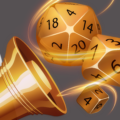MAKING IT YOUR OWN
- It all starts with making a Scenario. These are actions your character or army can do. Choose a custom icon, name it and then start assigning sounds. It is suggested you keep your naming conventions small, such as EvThrwHmr. Simply copy and paste a Scenario if you want to make another similar Scenario like, EvHammer. That way you’ll have unique stats and sounds for range and melee weapons. Handy for when you need to switch tactics.
- If you don’t see a sound you need, you’ve got choices~ use something similar in the gallery OR go Premium and upload your own sounds. You can even record your own in app! Still not satisfied, we are interested in what our users want. Share your thoughts at feedback@mysounddelve.com.
- Actions, Hits & Misses are the primary sounds that comprise each Scenario. They establish the sound effects that are played during the players turn. These sounds are found in the Sound Gallery. Once these sounds have been assigned, add your attack die/ dice.
- Attack is defaulted for RPG, which rolls all the dice into one result. Add your modifiers and if the “Standard” indicator is chosen, it will always stay. If the “Standard” indicator is not chosen but a modifier is entered, it will be applied for that single roll and then disappear.
- Advantage/ Disadvantage options are linked to the Attack section within the Scenario. Selection lasts one round then defaults back to off.
- Damage can be toggled for auto-calculations or left off if you prefer to manually roll for damage. If chosen, enter the dice type and modifiers just like the Attack section.
- Critical and Fumble sounds can be assigned and the roll numbers that make a critical role, such as 19-20 with a d20. Fumble is defaulted as a “1” on the roll. Apply the Critical Modifier (x2, x3, etc). Current default rule is to multiply the base damage dice then add the modifier(s). Once you create your scenario, you can edit the Critical Modifier by changing “20” to a lower number- handy for when a weapon threats with a lower number.
- Number Needed defines what makes a Hit or Miss. This number needed could be armor class or spell resistance. Once entered and the dice roll is activated either through shaking the phone or hitting the dice button, the sound effects are triggered. The resulting Attack roll and Damage rolls pop up in a notification window.
- Record your voice in the app, save it and assign a category and type to aid in your future search and assignments. We allow for up to 30 seconds per recording.
- Import your own sound files from a variety of locations such as iCloud Drive, Google Drive or Dropbox. Make sure to assign categories and types to these sounds to easily find them in the right sound gallery. It’s good to keep the name short.
- Icons are used to represent a Scenario. You can assign an image to each of your icons from your phone’s photo gallery. Change icons by editing in the scenario or holding the scenario icon down while on the scenario screen.
- Wallpaper can be customized or a variety of genre themed can be selected. Find wallpapers in Settings.
- Grouping is a way to best organize your sounds. Choose “Select” from the top right of the scenario screen. You’ll see circles pop up. Select the scenario icon you wish to group and press the 3 dots on the bottom left for choices: Create a Group/ Create a Group & Duplicate/ Duplicate or Add to Existing Group. Since characters & monsters can perform many actions, it is good to group them together and then create an icon for that group to keep track of them easily.
